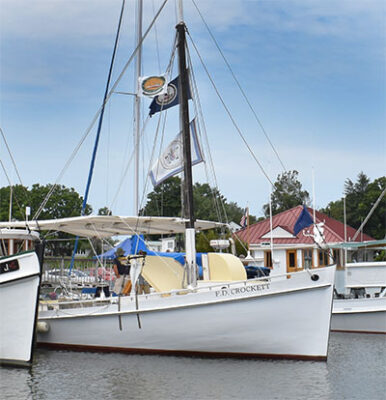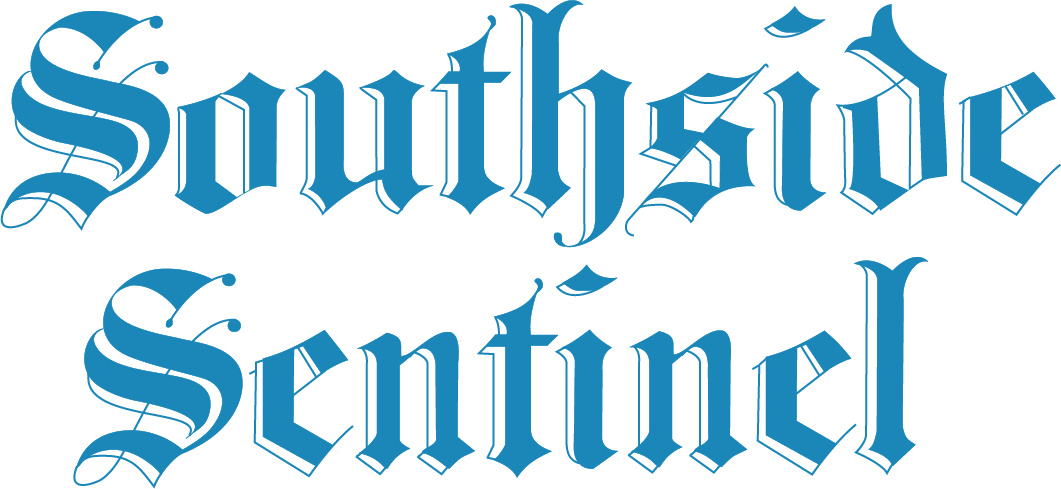(Editor’s note: The Deltaville Maritime Museum’s [DMM] restored and nationally historic registered log buyboat F.D. Crockett is one of eight restored buyboats and other historic craft that are this summer visiting visiting Onancock, Horn Harbor in Mathews, Smithfield Station, Smithfield and White House Cove Marina in Poquoson during their annual Chesapeake Bay cruise, which continues through Sunday, Aug. 7. The mission of these annual trips is to bring an understanding of these historic vessels to ports where they were once numerous, but now are often forgotten. The boats are being hosted by Smithfield Station, Smithfield, up until the morning of Friday, Aug. 5. The final weekend of the cruise will be at White House Cove Marina in Poquoson Friday-Sunday, Aug. 5-7. The boats will welcome the visiting public for limited hours during their time in port. To mark the special occasion, DMM Events Coordinator Bill Powell of Deltaville requested the Sentinel re-run his column from several years back explaining what a buyboat is. An updated version of it appears below.).

by Bill Powell –
At the Deltaville Maritime Museum, folks come by to see the buyboat F.D. Crockett, and the buyboat exhibits, and models in the museum — and they all ask, “What the heck is a buyboat?”
This column hopes to answer that question.
First of all, the 62-foot F.D. Crockett is a buyboat.
According to longtime Sentinel Reporter Larry Chowning’s definitive book “Chesapeake Bay Buyboats,” buyboats “range in size from 40-100 feet, have frame-built hulls, some are log built and most are deadrise” The Urbanna native continued, “The distinguishing characteristics are that there is a mast and boom configuration forward of the hold, the pilot house or house is aft of the hold, and the hull is decked over.”
Okay, now we know what it looks like, but why is it called a buyboat?
Well that’s pretty simple and just a little misleading because “BUY”-boats were called that because one of their many uses was to “buy” seafood from watermen off smaller boats and sell the seafood at one of the major markets such as Crisfield or Baltimore. This was only a small part of what they did!
Pound net boats needed the open hull for both the extra leverage it afforded the crew for pulling in the nets and the easy stowage.
Run boats or “runners” was the term used if the boat was owned by a seafood dealer and used mainly for running seafood from watermen to market.
The mast and boom configuration on the buyboats was used like a crane to load or unload seafood or other cargo to and from her holds and deck. On some occasions wood side panels were added to allow the vessels to pile seed oysters or other cargo in mountains on their decks.
In the real world of the working waterman, actually running a buyboat, the “buying” was a small part of its working day. “Captain Johnny” Ward of the buyboat “Iva W” out of Deltaville, kept his engine running 24 hours a day, six days a week.
On a typical week, Captain Johnny would fire up the Iva on Monday and “fish” (whatever was in season) all day, putting his catch in the hold. He would stop his fishing in time to rendezvous with other watermen, buying their catch until his hold and deck were filled with seafood.
The Iva would then run all night to Crisfield, Baltimore, or any market necessary to sell his catch. Rather than deadhead back, he would then act as a freight boat, bringing back any order he could carry. Building supplies, cloth, tools, engines, food staples were common freight. After dropping off its goods, the Iva would start the cycle all over again until Saturday evening when she would return to homeport for maintenance and church on Sunday.
OK, now we have read why it’s called a buyboat, what it did, and the other names it went by. If you really want to get a feel for what the watermen who ran them experienced, their history, and what their work was like, visit the Deltaville Maritime Museum. When she’s not carrying the museum’s living history message around the Bay, the F.D. Crockett is always on display at the Museum’s “Pierwalk.” You can walk her decks, peer in her holds, examine her rigging, stand at the helm and squeeze into the cramped quarters where a captain and two crewmen worked and lived 24 hours a day, six days a week. You really get a feel for what it was like!
Inside the museum, you can see intricate models of other historic buyboats and workcraft. There is a complete photographic record of the restoration of the Crockett from her arrival in Jackson Creek in 2005 through her current level of restoration. You can also learn what a “deadrise” is, see workboat building techniques and learn about the men who built them.
Deltaville Maritime Museum and Holly Point Nature Park, an all-volunteer, all-donation, non-profit organization, is located in Deltaville at 287 Jackson Creek Road and by water on Mill Creek. To get to the museum and park, follow General Puller Highway (Route 33) east through Deltaville and turn right across from the Chris Mart Citgo convenience store. Visit by car or boat. Holly Point Nature Park is open all year from dawn to dusk.
For information, call 804-776-7200.
DMM car show set for Oct. 15
The Deltaville Maritime Museum June 25 car show-cruise-in was a success, organizers say. It featured more than 70 cars — some from as far away as Delaware.
The next DMM car show-cruise-in is set for 10 a.m.-2 p.m. Saturday, Oct. 15. It is being offered in conjunction with the Taste of Middlesex Festival.
The show is open to all classic cars, trucks and tractors. Pre-registration is not required and there is no fee to participate in the show. All participants will receive one voucher per entry for one menu item at Bill’s Bistro and free admission to all DMM buildings and exhibits. As part of The Taste of Middlesex Festival, there will be free creek cruises on the museum deadrise “Jenny May,” as well as tours of the historic buyboat, “F.D Crockett.”
As this is a non-judged show, no trophies will be awarded, but there will be a drawing for door prizes. “This is a great venue for a family day car show as there will be vendors at the festival and children’s activities, as well as the chance to explore the Holly Point Nature Park,” a show spokesman said.
DMM is located at 287 Jackson Creek Road in Deltaville.
For information, visit the museum website at http://www.deltavillemuseum.
(Gordon Gibb contributed to this column.)



